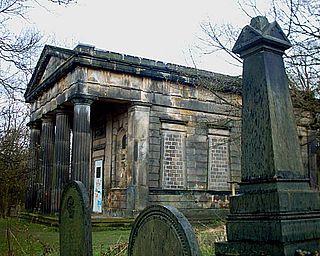
Augustus Welby Northmore Pugin was an English architect, designer, artist and critic with French and Swiss origins. He is principally remembered for his pioneering role in the Gothic Revival style of architecture. His work culminated in designing the interior of the Palace of Westminster in Westminster, London, and its iconic clock tower, later renamed the Elizabeth Tower, which houses the bell known as Big Ben. Pugin designed many churches in England, and some in Ireland and Australia. He was the son of Auguste Pugin, and the father of Edward Welby Pugin and Peter Paul Pugin, who continued his architectural firm as Pugin & Pugin.

The Dean Cemetery is a historically important Victorian cemetery north of the Dean Village, west of Edinburgh city centre, in Scotland. It lies between Queensferry Road and the Water of Leith, bounded on its east side by Dean Path and on its west by the Dean Gallery. A 20th-century extension lies detached from the main cemetery to the north of Ravelston Terrace. The main cemetery is accessible through the main gate on its east side, through a "grace and favour" access door from the grounds of Dean Gallery and from Ravelston Terrace. The modern extension is only accessible at the junction of Dean Path and Queensferry Road.

John Mitchel was a Protestant Irish nationalist activist, author, and political journalist. In the Famine years of the 1840s he was a leading writer for The Nation newspaper produced by the Young Ireland group and their splinter from Daniel O'Connell's Repeal Association, the Irish Confederation. As editor of his own paper, the United Irishman, in 1848 Mitchel was sentenced to 14-years penal transportation, the penalty for his advocacy of James Fintan Lalor's programme of co-ordinated resistance to exactions of landlords and to the continued shipment of harvests to England.

Sir Robert Rowand Anderson, was a Scottish Victorian architect. Anderson trained in the office of George Gilbert Scott in London before setting up his own practice in Edinburgh in 1860. During the 1860s his main work was small churches in the 'First Pointed' style that is characteristic of Scott's former assistants. By 1880 his practice was designing some of the most prestigious public and private buildings in Scotland.

William Burn was a Scottish architect. He received major commissions from the age of 20 until his death at 81. He built in many styles and was a pioneer of the Scottish Baronial Revival,often referred to as the golden age of Scottish architecture.
Robert William Billings was a British architect and author. He trained as a topographical draughtsman, wrote and illustrated many books early in his career, before concentrating on his architectural practice.

St John's Church, Ranmoor is a large parish church in Ranmoor, a suburb of the City of Sheffield, England. It is a Church of England church in the Diocese of Sheffield, and it is the second church to be built on this site after the original church was destroyed by fire in 1887. It has a 200-foot-tall (61 m) tower and spire, the tallest church spire in Sheffield.

Sheffield Old Town Hall is a building in Waingate in central Sheffield, South Yorkshire, England, opposite Castle Market. It is a Grade II listed building.

Thomas Penson, or Thomas Penson the younger was the county surveyor of Denbighshire and Montgomeryshire, and an innovative architect and designer of a number of masonry arch bridges over the River Severn and elsewhere.

Upper Chapel is a Unitarian chapel on Norfolk Street in Sheffield City Centre. It is a member of the General Assembly of Unitarian and Free Christian Churches, the umbrella organisation for British Unitarians. The Chapel is Grade II listed.

Henry Francis Lockwood was an influential English architect active in the North of England.

The Mount is a Grade II* listed building situated on Glossop Road in the Broomhill area of Sheffield in England. It stands just over 1.3 miles (2.1 km) west of the city centre. It is a neoclassical building which was originally a terrace of eight houses but since the 1950s has been used for commercial office space for various businesses. The building is part of the Broomhill Conservation Area, which was set up in March 1977 through an agreement with local residents and Sheffield City Council.

Edward James Willson (1787–1854) was an English architect, antiquary, architectural writer, and mayor of Lincoln in 1851–2.

William Gibbs (1790–1875) was an English businessman, best known as one of three founding partners in Antony Gibbs & Sons, a religious philanthropist, and the owner who developed Tyntesfield in Wraxall, North Somerset.

Edward Haycock Sr. was an English architect working in the West Midlands and in central and southern Wales in the late Georgian and early Victorian periods.

William Wallen FSA (1807–1888) was an English architect who practised in London and Huddersfield, Yorkshire. He was also a campaigner for better architectural education and professional status.

Samuel Worth was an architect based in Sheffield.


















